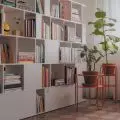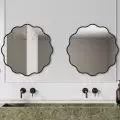The design of the readaptation and reconditioning center created by Natalia Madej of the Faculty of Architecture at Wroclaw University of Technology is a response to the growing number of veterans with psychological and social injuries. The facility, located in the charming and quiet surroundings of a reservoir in Stradomia Wierzchnia, is the next stop on the road to improving mental health and re-acclimatization in the country.
orientation
© Natalia Madej
destination
The designed readaptation and reconditioning center aims to support veterans after foreign military missions and their loved ones who have directly or indirectly experienced traumatizing events. Individuals struggling with PTSD can be vulnerable to triggering an attack by a variety of stimuli. It is crucial to create an architecture that minimizes this risk and supports the acclimatization process. The facility, in the form of a hotel, offers not only accommodation, but also psychological support, a variety of recreation, integration and opportunities to take care of guests' physical fitness. The design takes into account natural variables such as sound, light, color, smell and nature's surroundings, which supports physical and mental recovery.
north elevation
© Natalia Madej
eco-friendly technologies
The center's building was designed with the condition of the environment in mind. The structural walls are made of ecological material - rammed earth technology is an important aspect of the idea of the whole establishment. It significantly reduces CO₂ emissions, thanks to the way rammed earth buildings are constructed. The mixture is not burned, and material from the construction site can often be used for construction. Partitions made with this technology also have many advantages for the users and occupants of the building. Thanks to such features as high mass and volume, they are "breathable " - they regulate air humidity, have a positive effect on the microclimate of the interior. In addition, the use of greater thickness of the walls, makes the structure a great acoustic insulator.
south elevation
© Natalia Madej
functional layout
The architectural prem ise is oriented longitudinally, with a slight deviation from the north-south axis, and takes advantage of the difference in terrain. The building was partially dug into the ground and flattened in the northern and eastern parts of the plot. The simple body consists of two above-ground floors. Thanks to its small height, the building blends harmoniously into its natural surroundings. From the access side, only the smaller blocks of the hotel are visible, and the whole creates a clearly defined entrance zone and courtyard, which is the main outdoor recreation zone.
visualization
© Natalia Madej
The functional layout of the first floor is based on a core of common areas, around which communication of guests and employees takes place. Workshop spaces, exercise and therapy rooms are arranged by means of transverse walls. On the southeast side, the core is glazed, allowing the interiors to open up to the view. At the ends of the core are two-level vertical communication and viewing and integration areas. There is also a climbing wall in this section, accessible to all visitors, including those with limited mobility.
visualization
© Natalia Madej
On the first floor, along a wide corridor, there are rooms for guests, inverted by 90 degrees with respect to the viewing qualities. This treatment, along with the placement of the common area in the area of the best view, is intended to motivate guests to spend time in the recreational areas and integrate together. The connecting element between the two sleeping areas is a terrace on the utility roof, offering a space with excellent viewing qualities, filled with greenery, seating areas and a sports zone.
visualization
© Natalia Madej
Natalia Madej recognizes that architecture can influence the well-being and comfort of male and female users by consciously designing spaces that engage all the senses. The project in Stradomia Wierzchnia is an example of how a properly designed space can support readaptive processes, improve mental health and promote environmental sustainability.



















































